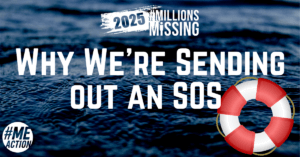By Eileen Rosenbloom
You might think aging with myalgic encephalomyelitis (ME) is a seamless dance where an illness catches up with a stage of life. As people age with their own set of ailments, you’d hope this latter stage would offer a welcome mat of normalcy.
Our healthy peers would like us to think so. They say we’re all getting old and they’re tired too. Such words do not placate us, however, especially when they also spout platitudes such as, “60 is the new 40!” As a 60-something person with ME, it feels more like 60 is the new 80 except when my mother was 80, she was far more energetic and active than I am now.
One thing is clear: for better or worse, our generation is not our grandma’s senior. They’re fit, health conscious, and attack new wrinkles with the angst of a 13-year-old who awakens to a fresh zit. They swear, in this day and age, we will live to 100. That’s a lot of time to pursue bucket lists and, let’s be honest: bucket lists are for the healthy, not the sick. While healthy seniors might plan a cross-country tour, we’re just trying to navigate a trip to the bathroom.
When people reach their latter years and particularly as they retire from lifelong work, they entertain thoughts of relevance. To maintain a sense of meaning, they might volunteer or pursue hobbies they didn’t have time for while in the throes of career and family.
How then do we with ME find meaning when we’ve been stripped of so much of what previously defined us? Are we still relevant? Or relics left over from a time now obsolete?
Years ago before ME, I visited Italy. While strolling through the ruins of the Roman Forum, I marveled at the remains of destruction and abandonment. Many statues lacked limbs and heads. Although not in their former glory, these deformed beauties continued to enthrall. My companion commented that if this were the United States, they’d have razed the entire Forum and built condominiums in its place, basically committing architectural euthanasia. It could have been argued that the site no longer had any utilitarian purpose, but as we gazed at the sculptures, the beauty of history brought to life was undeniable. Despite the obvious deformities, we stood transfixed before the temples, arches, and beheaded statues, transported back in time. In fact, it was those missing limbs and broken columns that breathed with stories of a time past.
Like the ruins, those of us with ME have lived through our own battles. Our finish is worn; our broken edges rough. Yet, no matter how much illness diminishes what used to be, our beating hearts still pulsate among the rubble. Our ability to love is off limits to that which destroys, even if we must find new ways to express caring. We may be missing parts once useful, but our broken, fragmented selves stand like ruins of old. Our empty spaces cradle tales of survival and perseverance.
We are the ruins of what has been. If you listen closely, you’ll hear our whispered stories.

SOS: Save our Science
People disabled by ME and Long Covid across the UK send out an SOS. It’s time to send out our SOS signal, if we want to have funded research. May 12th, is Myalgic Encephalomyelitis Awareness Day. On this day, the #MillionsMissing of people with myalgic encephalomyelitis (ME) gather to demand an increase in research and




9 thoughts on “Ruins: An ME Senior's Perspective”
As a person with ME for thirty years and counting, I loved the image of the Greek and Roman statues, missing limbs, cracked, damaged -but still beautiful. In the ME Action Seniors group, older people with ME have shared the most painful and demanding life experiences and circumstances. In spite of this, I have found the insight and compassion people also express in the group, very moving. To live for many years with a condition like ME, is truly a great achievement of human courage and endurance and should be honoured as such. Well done. Eileen.
For patients over the age of 55, please join us in the #MEAction Senior Connect Group on Facebook.
https://www.facebook.com/groups/391269901334695/
Wow, thank you Eileen Rosenbloom. Your writing and perspective deeply touched me. It brought tears up though tears seem lately always to be waiting to be given voice. I am 61 and have had ME for 32 years along with a myriad of other medical problems that also affect functioning and quality of life, like all of us have.
But in the last six months I’ve had eight vertebral compression fractures (the vertebrae fracture and collapse) caused by severe osteoporosis. And my torso has collapsed 3 and 1/2 inches and my spine is deformed. I’m struggling to accept the, for me, profound changes in my body shape along with all the other changes ME has caused. I only look in the mirror as if to gawk at this ‘freak show.’ But hearing your story about the ruins and the stories they told gave me a glimmer of light or hope. I will work to look at myself in a different light-as one of those ruins, as someone who has battled for so many years, endured wounds and degradation but has always kept fighting. And changing and evolving in so many ways not outwardly visible. (Sorry, I’m struggling for words!)
As a 57 year old Severe ME sufferer for 26 years, I relate to each and every word this author writes about the effects of ME on the aging. Although I am only 57, my husband of 37 years is 68. He is retiring next month mostly due to the ever increasing at-home care I need.
He knows that just bathing and brushing teeth are strenuous activities that I put off for days and weeks at a time, yet he is talking about all the things we will ‘do’ when he is retired. Is he just hopeful? Has he been walking through the last 26 years blind? Does he think that his mere presence will make a 90% difference in what I will be able to do? Hpefullness left me years ago-yet it tears me up inside that my dear husband still doesn’t get it.
Aww Katharine, your comment breaks my heart (my already-broken heart). Now I’m at a loss for words. It’s heartbreaking to live with someone for so long, someone who sees what your life is like day in and day out and still doesn’t really see or accept it. It’s awfully lonely.
Beautifully expressed! 40 years of ME have laid a patina of grace, patience, understanding and love that ease could not have, and I treasure what I have become, even as I sigh over the limitations and losses. And, as I look forward to restoration and regaining, now that I have upgraded medical care (finally being seen by a research clinical MD) and have new access to ME lifestyle mentoring. Thank you for these words. Their wisdom encourages and affirms.
22 now 55. A life as a couple with ME. Yes, I had hoped age and ME would become almost indistinguishable; the folly of youth! The earlier years – 30’s and 40’s – looked forward to the time of retirement holidays and OAP rail fares. A time when, with family and work done, a slower pace and less stress would leave us with spare energy. All we find is there is no spare energy, indeed, there never was- we lived a life on failing batteries and were able to because of the relative advantages of youth. I say relative because we have the same failing batteries but now they are corroding due to age. Sights set lower but it wasn’t hard- the desire to globe-trot has diminished and been replaced with realism; thoughts of a cup of tea and a book until nodding off replaces that swim and tequila in the sun. I am weary. I have resigned myself to continue to be denied what is so normal for others my age. My age at 25 or 55- it makes no odds. I now see that at any age, ME relativizes. RIP drips with irony.
Eileen, as a 57 year old who has had ME for over 30 years, you touched on a topic that consumed my mind so often. I desire so badly to be able to function normally, to be what I consider to be a “real” human, and daily fight the unbelief that engulfs my mind regarding what is my body’s daily hour by hour decline. Unbelief that another day has come where my body succumbs to something I cannot understand nor can I grasp an illness so powerful that it keeps me, like a magnet draws metal, returning to inability, pain and loss. It keeps me like a magnet, pulling me and forcing me to stop and lie down.
My bed is my magnet.
My bed is my comfort.
Yes, being misunderstood is also an ache deep down and few will rarely get what we mean by “fatigue”. Truly, I do not believe there is an English word that can describe what is ME.
I am thankful we have this site and others to share with other souls in the sa.e situation. It helps. We can look for the gem in the rubble.
Thanks for your article. Really.
Brilliantly written.
Comments are closed.